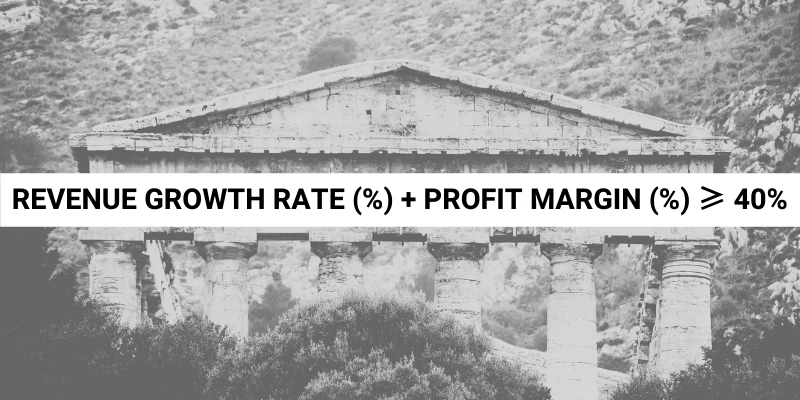The Rule of 40 Explained: A Balanced Benchmark for SaaS Success

For SaaS businesses, growth and profitability are often treated as the single most important indicators of success. But what if there was a way to measure both in harmony? Enter the Rule of 40 — a simple yet powerful formula that has become a North Star for SaaS founders, investors, and sales professionals alike.
This guide will break down exactly what the Rule of 40 is, why it matters, and how it can help ensure healthy, sustainable growth for tech companies. We’ll also show why sales professionals should care about this metric and how it can influence both strategy and results.
What Is the Rule of 40?
At its core, the Rule of 40 is a benchmark used primarily in the SaaS and tech industries to assess whether a company is balancing growth and profitability effectively. Here’s how it works:
The Rule of 40 states that a company’s revenue growth rate combined with its profit margin should be equal to or greater than 40%.
Here’s the formula in action:
Revenue Growth Rate (%) + Profit Margin (%) ≥ 40%
For example:
- A SaaS company with a revenue growth rate of 30% and a profit margin of 10% meets the Rule of 40 (30% + 10% = 40%).
- Another company with a revenue growth rate of 10% but a profit margin of 30% also satisfies the Rule of 40 (10% + 30% = 40%).
The Rule of 40 is intentionally flexible. Different companies have different strategies—some prioritize rapid growth, while others focus on operational efficiency and profitability. This rule allows businesses to strike a balance, ensuring they’re meeting investor expectations without becoming too one-dimensional.
Why Is the Rule of 40 Important for SaaS Businesses?
The Rule of 40 isn’t just a nice heuristic — it’s a reflection of a SaaS company’s overall health and scalability.
1. Growth Alone Isn’t Enough
Rapid growth may look impressive on the surface, but without profitability, it can quickly become unsustainable. Relying too heavily on growth often means burning cash to acquire customers at an unsustainable pace. Over time, this can create vulnerabilities if market conditions shift or funding dries up.
Imagine a SaaS business achieving 50% annual revenue growth, but with a negative profit margin of -30%. Their combined score here is just 20%, well below the Rule of 40. While the growth is flashy, the company is hemorrhaging cash — an obvious red flag to investors.
2. Profitability Alone Isn’t Enough Either
While securing high profit margins might make a business look efficient, it can also signal a lack of investment in growth. For SaaS companies, where the total addressable market (TAM) is often enormous, under-investing in areas like customer acquisition, R&D, or customer success can lead to flatlining results.
A company with a 50% profit margin but only 5% growth would have a Rule of 40 score of 55%, which is technically great. However, if they’re plateauing in their market, this might indicate missed opportunities for expansion.
3. A Balanced Approach Wins
The Rule of 40 strikes a healthy balance between these extremes. It ensures that businesses focus on sustainable growth while maintaining a financial foundation strong enough to weather challenges like market downturns or changes in customer behavior.
The Rule of 40 and Healthy Growth
When applied correctly, the Rule of 40 shifts the narrative from “growth at all costs” to “healthy, sustainable growth”—a mindset that’s vital for long-term success.
Metrics Beyond Revenue
While revenue and growth are core, they shouldn’t live in isolation. Here are a few additional metrics that SaaS leaders and sales professionals should consider alongside the Rule of 40:
- Customer Retention Rate: Long-term growth is built on happy, loyal customers. Understanding your retention rate will help you build more predictable revenue streams.
- LTV:CAC Ratio (Customer Lifetime Value to Customer Acquisition Cost): This metric reveals whether the revenue generated from a customer outweighs the cost of acquiring them. A strong balance aligns closely with Rule of 40 principles.
- Burn Rate and Cash Runway: If you’re burning through cash to fuel growth, knowing how long you can sustain that level of spending is critical.
Tailored Metrics for Different Stages
It’s important to remember that the Rule of 40 isn’t one-size-fits-all. Early-stage startups might pay more attention to revenue growth, while mature companies dial in on profitability. Here’s how the Rule of 40 might vary by stage:
- Early-Stage Startups: Aggressive growth with lower profitability. Rule of 40 factor might weigh more heavily toward faster revenue growth (e.g., 35% growth, 5% profit margin).
- Mid-Stage Companies: A more even mix of profitability and growth.
- Later-Stage or Pre-IPO Companies: Strong profitability takes precedence while sustaining moderate revenue growth.
Why the Rule of 40 Matters for Sales Professionals
The Rule of 40 isn’t just for founders or investors—it holds significant value for sales teams as well. Here’s why:
1. Align Sales Efforts with Business Priorities
If a company is leaning toward profitability, the sales team might focus more on retaining high-value customers, upselling existing accounts, or finding customers with higher lifetime value. On the other hand, if the company is chasing revenue growth, sales strategies might shift toward rapid new customer acquisition, even if it means offering discounts or promos.
2. Better Accountability for Sales Performance
The Rule of 40 provides sales professionals with an overarching framework to measure their contribution to both growth and sustainability. Closing deals is important—but ensuring that those deals align with healthy profit margins takes center stage.
3. Stronger Negotiation Leverage
When you understand the financial drivers of your company, you can position yourself as more than just a salesperson — you’re a strategic partner. Whether you’re working with finance, product teams, or directly with clients, knowing how your deals impact metrics like profitability and revenue can improve both your results and recognition.
Growing Smarter in SaaS
For SaaS companies and tech startups, the Rule of 40 provides a helpful lens to look beyond surface-level growth metrics. By balancing revenue growth with profitability, businesses ensure their foundation can support sustained success—even in turbulent markets.
For sales professionals, this isn’t just a number; it’s a strategy. Understanding how the Rule of 40 works allows you to align your efforts with your company’s overall health, gain a competitive edge, and close better deals with more confidence.
Focus on healthy growth — not just growth for its own sake — and you’ll help your business scale while meeting broader organizational goals. Feel free to check out the Tech Sales Temple Community forum to discuss topics like the rule of 40 with other professionals.
